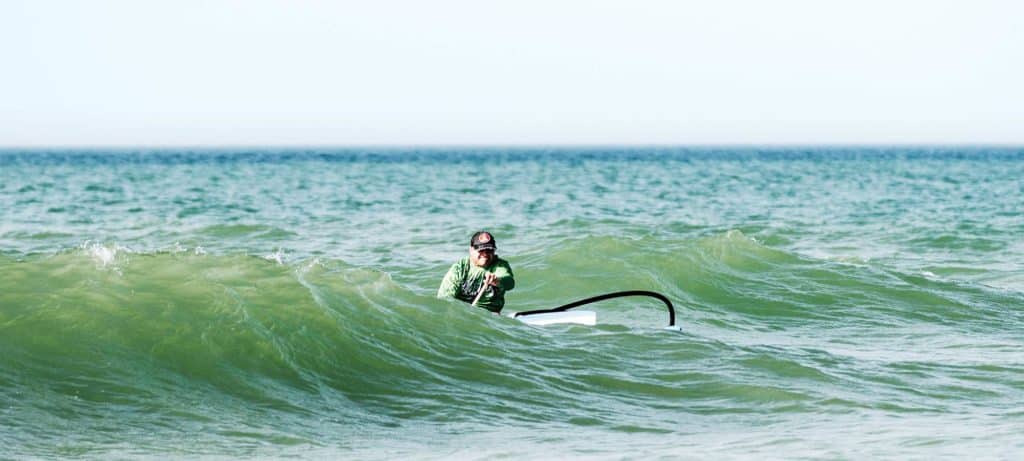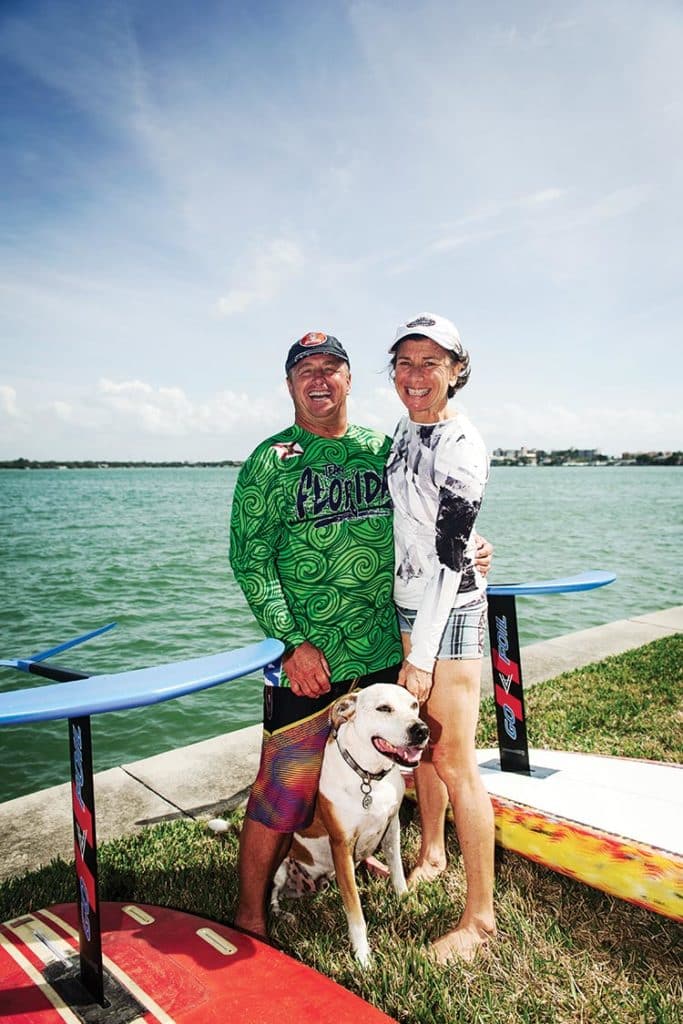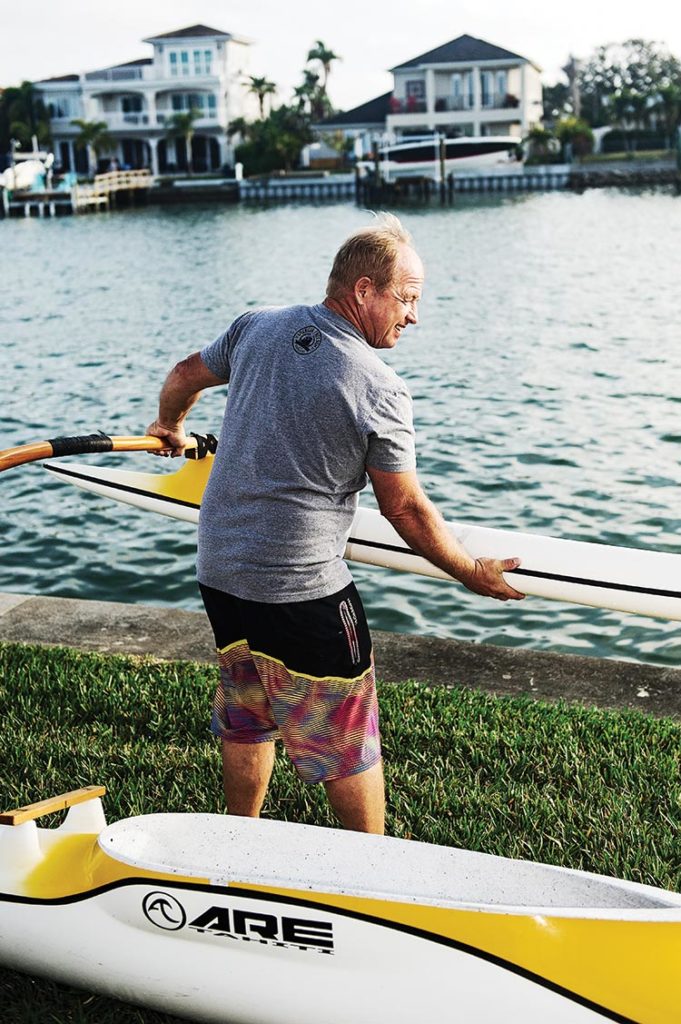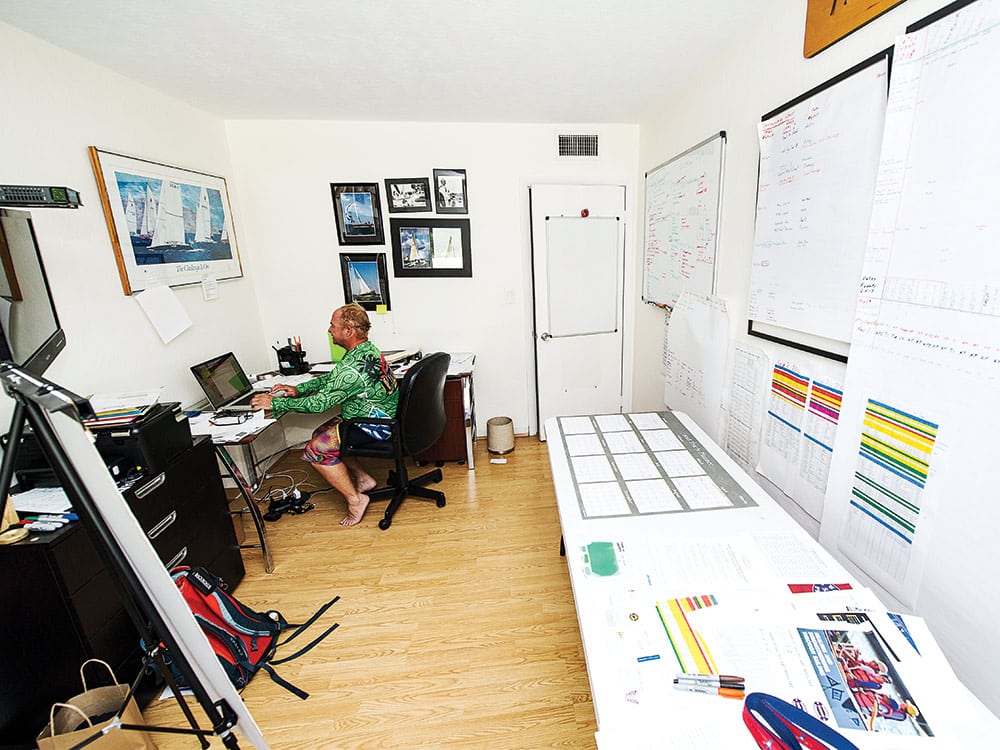
Ralf Steitz, president of U.S. Merchant Marine Academy Sailing Foundation, speaks his mind. His friends say it’s one of his most endearing qualities — that and his reputation as a veracious and convivial old soul. Yes, Steitz, 55, is quintessentially German: direct and clear about his intentions and expectations of those under his watch, of whom there have been many. You always know where you stand with “Ralfie,” one of American offshore sailing’s most influential leaders today.
Steitz grew up on Heligoland, a German archipelago of two islands in the southeast corner of the North Sea. It’s an area with an explosive history, occupied by the Danish and British, and evacuated during both world wars to avoid mass casualties. From 1945 to 1952, when the island was under British control, Heligoland was used as a bombing range. The Royal Navy once detonated 6,700 tons of explosives in one of the largest single non-nuclear detonations in history.
By the time Steitz was born in January 1963, Heligoland had morphed into a tourist destination for Germans. Steitz’s parents owned a restaurant on the island, which enjoyed great visitor rates as a duty-free zone. Cigarettes, alcohol and perfume were easier to come by than in mainland Germany, 30 miles to the east. In the late 1960s, Heligoland was also an idyllic training venue for offshore racers. The tidal currents surrounding the .4-square-mile island and its smaller sister island offered conditions approximating the English Channel.
Trials for the German Admiral’s Cup team were conducted in Heligoland in 1969 and 1973, and the One Ton Cup was contested off its coastline twice in the 1960s. The One Ton Cup in 1969, won by Chris Bouzaid’s New Zealand boat Rainbow 2, whetted Steitz’s appetite for sailing at the age of 6.
Steitz came of age in a time when German racing yachts were making an impact on the global racing scene — the Admiral’s Cup and the Southern Ocean Racing Conference.
“I was fascinated that these guys from New Zealand traveled all the way to freaking Heligoland,” says Steitz. “It was guys like Roy Dickson and Bouzaid, the first guys to leave New Zealand and be dominant overseas.”
During the One Ton Cup in 1969, he adds, New Zealanders would visit his parents’ restaurant. “They helped pay for my first Optimist,” he says.

Steitz quickly learned that sailing could be a means to “get off the rock,” and by 1975, when he was 12, he was sailing on the Dick Carter-designed Carina III, a member of the winning 1973 German Admiral’s Cup team, commanding the bow and earning his stripes. Six years later, Steitz raced the Admiral’s Cup for Germany aboard a Judel/Vrolijk-designed 40-footer.
“I did my apprenticeship as a sailmaker in a small loft above a boatyard in Wedel, outside of Hamburg,” says Steitz. “It’s the same place where Judel/Vrolijk had their first office. I met Rolf Vrolijk, who designed Dusselboot for the 1981 Admiral’s Cup. It was built where I was working and was easy to get on. I knew everybody.”
Steitz’s foray into the Admiral’s Cup wasn’t his first visit to England. He went to Cowes Week in 1978, and was there again in 1979 aboard a 40-footer named Champagne, hoping to make the German Admiral’s Cup team. Champagne didn’t make the cut, and Steitz was on board for the return delivery to Germany during a Force 10 storm that ravaged the Fastnet Race fleet. “We made it back in record time,” he says. “It was downwind.”
Steitz came of age in a time when German racing yachts were making an impact on the global racing scene. The Admiral’s Cup and the Southern Ocean Racing Conference were popular, and the German yachts Container, Diva, Dusselboot, Outsider, Pinta and Saudade made headlines. They were groundbreaking yachts that pushed the handicap rules of the day, and Steitz, nicknamed the “Bionic Baby” because of his stout build and full head of blond hair, was smack in the middle of it all.
“I could kick anyone’s ass,” he says boastfully, followed by a chuckle.
He sailed the Admiral’s Cup three times, representing Germany in 1981, Austria in 1985 and Australia in 1987, and has since crewed on a staggering variety of yachts. He has raced the four major ocean races and the world match-racing circuit. He also has three America’s Cup campaigns under his belt, with Team Dennis Conner in 1992 and 1995 and Paul Cayard’s AmericaOne in 2000. His fortunes have been plentiful in the sport, a result of his work ethic and sheer strength.
“Sailing brought Ralfie from Heligoland to the United States via the world,” says Cayard. “He was the prototypical young sailor who would do anything on a boat for the right of passage to a foreign land.”
Everyone he sailed with back then worked hard, Steitz says. “Doors have always opened up for me whenever I traveled, and I’ve always wanted to give that back. I’ve been treated unbelievably nicely through the years, and I have to pay that forward.”
He’s reached that point in his life, he says, where he’s more interested in advancing the opportunities of others rather than his own. He’s discovered the means to do so with Warrior Sailing, a program of the USMMA Sailing Foundation. The foundation solicits vessel donations to be used for education and training programs, and since 2007, more than 150 yachts have been donated. The yachts must be retained for three years before the foundation can sell them, and the continual turnover of the donations helps fund the foundation’s programs, including Warrior Sailing and the USMMA’s offshore sailing program.

Steitz coached the Kings Point offshore team as a volunteer in the early 1990s after settling in Port Washington, New York. Today, he’s taken it upon himself to help teenage and 20-something-year-old aspiring sailors find successful racing careers.
As a coach for the Morning Light project in 2007, he saw a group of sailors from the ages of 18 to 23 race the Transpac aboard a TP52. He was also the driving force behind the All-American Offshore Team, another effort that put young sailors in charge of a 65-footer for the Rolex Transatlantic Race of 2011. Each time, the crew included Charlie Enright and Mark Towill, both products of the Brown University sailing team, and Chris Branning, a USMMA-bred navigator.
Branning, 32, enrolled at the USMMA as a successful Laser sailor from high school after having won the 2004 Cressy Trophy, the singlehanded championship for high schoolers. Branning says he never thought about sailing beyond the Laser until he met Steitz, who helped him secure a year off from the service academy to participate in the Morning Light project when he was 22 years old.
“All I knew of Ralfie before I got to Kings Point was that he was the mystery bowman from the America’s Cup and a man to be respected,” says Branning. “He’s a facilitator, an educator. He doesn’t spike anyone in a public setting. His interest is in seeing people grow, and no one grows that way. He praises you in public and tells you how to improve in private. He’s a guy who cares. Every day is the best day when you’re hanging out with Ralfie. He’s like the coolest uncle you’ve ever had.”
Enright, Towill and Branning are among Steitz’s most prized pupils. The trio recorded a third-in-class in the 2007 Transpac Race, sixth place overall in the 2011 Transatlantic Race and third overall in the 2011 Rolex Fastnet Race. Branning has also navigated the super-maxi Rio 100 to Barn Door honors in the 2015 Transpac Race and the elapsed-time record in the 2016 Pacific Cup (San Francisco to Hawaii), while Enright and Towill have gone on to twice represent the United States in the Volvo Ocean Race with Team Alvimedica and Vestas 11th Hour Racing.
“Ralf is the most benevolent guy in all of sailing,” says Enright. “He provides opportunity to anyone with ambition. There is no way, absolutely no way, we would be where we are without Ralf’s help and the help of the USMMA Sailing Foundation.”
For his part, Steitz is happier when he’s sharing his knowledge of sailing, especially with younger age groups. Cayard says the most important race the two did together was the 2008 Pacific Cup, with six kids aboard the Cayard family’s Santa Cruz 50, Hula Girl. “Ralfie was in his element, sharing his seamanship with the kids in a way that few adults can,” says Cayard. “He was instructive, motivating and nurturing all at once. He’s the most enthusiastic person in sailing; upbeat, positive and competent.”
He’s now lending those talents to the betterment of veterans of military service. One of his goals wherever he’s teaching is to increase participation in sailing. With Warrior Sailing, he’s also giving veterans coping with post-traumatic stress disorder an alternative to sitting at home alone, struggling to integrate with society.
“Ralfie loves to be hands-on,” says Jen French, co-founder of Warrior Sailing. “He’s been coaching at the clinics from day one because he loves working with the veterans, but the great thing about him is that he’s a visionary. He can take a step back and see a direction forward, and he turns his vision into reality.”
Steitz is more interested in advancing the opportunities of others than his own. He’s discovered the means to do so with Warrior Sailing.
Warrior Sailing grew out of Steitz’s desire to work with veterans. He had been a part-time coach for JP Creignou and French in their run-up to the 2012 Paralympic Games, where the duo won a silver medal in the two-person SKUD 18 class. After the Games, French, a quadriplegic due to a snowboarding accident in 1998, sat with Steitz, and they put together a framework for a sailing program that would benefit veterans.
“We had two premises,” says French. “We didn’t just want to take people for boat rides; we wanted to teach them sailing to expand the sport.”
Warrior Sailing has accommodated more than 250 veterans since its first basic sailing camp in November 2013. Veterans, male and female and with varying disabilities, come from many parts of the United States for the weeklong sessions that are completely funded. Whether or not they’ve suffered the loss of a limb, nearly each one of them copes with some degree of PTSD. The more severe cases might preclude them from enjoying communal settings. Veterans miss the camaraderie of their brothers in arms, and Warrior Sailing helps find a way to acclimate to life again.

“What I love about this program is that it’s holistic,” says Corey Kapes, a certified therapeutic recreation specialist who joined Warrior Sailing after working with the Department of Veterans Affairs, helping veterans transition back to home life. “It’s 100 percent group therapy; it’s occupational therapy, physical therapy, recreational therapy. We have the same goals and strive for the same outcomes whether it’s physical, social, emotional, you name it. We achieve everything achieved in a typical rehab setting; we’re just going sailing to do it.”
Warrior Sailing has grown to offer advanced clinics for veterans and also helps the veterans administration with its annual one-day summer sports clinics in San Diego. It also has taken another 20 veterans directly into offshore races.
Sammy Lugo, one of the program’s first sailors, might be its greatest success story. Lugo served in the U.S. Army and lost his right leg in Iraq in 2007 during a routine patrol. “We got a few hundred yards away from a checkpoint and got hit by a roadside bomb,” Lugo says. “I was the gunner in the vehicle, and I suffered my physical casualties in the legs.”
Lugo’s left leg is amputated below the knee. He also broke his right leg in three places during the same incident. He has participated in as many sports as possible as a means of therapy, including cycling, dragon-boat racing and sailing, but stuck with sailing and has raced the J/22 Worlds, the Sonar Worlds, the Blind Sailing Worlds (crewing for a friend), 12-Meters on Narragansett Bay and the Miami-Havana Race on an 83-footer. Now he helps as a coach at the basic sailing clinics.
“Sailing can be as easy as you want it to be or as hard as you want it to be,” says Lugo. “There are small boats and big boats, slow boats and fast boats. It depends on what you’re up for. In sailing, you get together, eat together, party, socialize. It’s a great group setting. Sailing has lifted me from being home, doing nothing. Now, with coaching, I get invited back more often. It’s fun.”
Steitz, French, Kapes, program director Ben Poucher, whom Steitz plucked from the ranks of Class 40 sailing, and the cadre of volunteers that assist the program, depending on its locale, say the program is working to put many people in sailing that might not otherwise have the chance. Due to those efforts, and those of Dave Scott, a professional sailor, sailing is set to be a medal sport in the 2018 Invictus Games in Australia in October. The games are for wounded veterans of military service around the world, and sailing will be a featured sport.
For his efforts, Steitz has been the recipient of numerous awards, and whether he’s at a lectern delivering a keynote speech or teaching a figure-eight knot to a veteran, he always has everyone standing at attention, figuratively if not literally.









